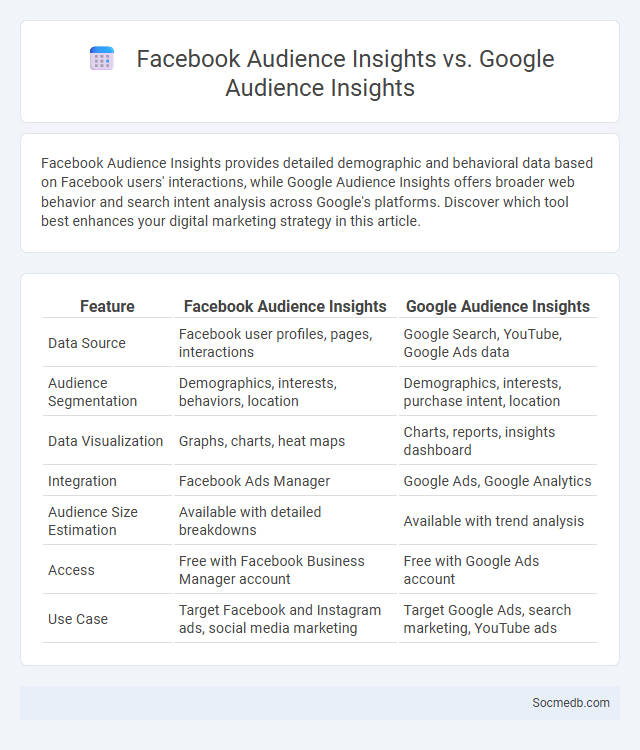
Photo illustration: Facebook Audience Insights vs Google Audience Insights
Facebook Audience Insights provides detailed demographic and behavioral data based on Facebook users' interactions, while Google Audience Insights offers broader web behavior and search intent analysis across Google's platforms. Discover which tool best enhances your digital marketing strategy in this article.
Table of Comparison
| Feature | Facebook Audience Insights | Google Audience Insights |
|---|---|---|
| Data Source | Facebook user profiles, pages, interactions | Google Search, YouTube, Google Ads data |
| Audience Segmentation | Demographics, interests, behaviors, location | Demographics, interests, purchase intent, location |
| Data Visualization | Graphs, charts, heat maps | Charts, reports, insights dashboard |
| Integration | Facebook Ads Manager | Google Ads, Google Analytics |
| Audience Size Estimation | Available with detailed breakdowns | Available with trend analysis |
| Access | Free with Facebook Business Manager account | Free with Google Ads account |
| Use Case | Target Facebook and Instagram ads, social media marketing | Target Google Ads, search marketing, YouTube ads |
Overview of Facebook Audience Insights
Facebook Audience Insights provides marketers with comprehensive data on user demographics, interests, and behaviors to optimize ad targeting. It offers valuable metrics including age, gender, location, relationship status, page likes, and device usage, enabling precise audience segmentation. By analyzing this data, businesses can enhance campaign effectiveness and improve return on investment (ROI) through tailored content strategies.
Overview of Google Audience Insights
Google Audience Insights provides in-depth analytics on user demographics, interests, and online behaviors across Google platforms. It leverages data from search patterns, YouTube activity, and website interactions to help marketers understand audience segments and optimize targeting strategies. This tool enables precise audience profiling for improved campaign performance and higher ROI in social media marketing.
Key Differences Between Facebook and Google Insights
Facebook provides detailed insights on audience demographics, engagement metrics, and ad performance within its platform, allowing you to target and optimize social campaigns effectively. Google Insights, primarily through Google Analytics, offers comprehensive data on website traffic sources, user behavior, and conversion tracking across multiple channels. Understanding these key differences enhances your ability to leverage social media analytics for more informed marketing decisions.
Data Sources and User Demographics
Social media platforms gather extensive data from diverse sources, including user-generated content, behavioral interactions, and third-party integrations, enabling precise audience targeting. The user demographics span various age groups, with a significant concentration of millennials and Gen Z, who dominate engagement and content creation. Analytics tools leverage this demographic data to optimize marketing strategies and enhance user experience across platforms.
Targeting Capabilities and Segmentation
Social media platforms offer advanced targeting capabilities that allow advertisers to reach specific audiences based on demographics, interests, behaviors, and location. Precise segmentation enables your campaigns to deliver personalized content, maximizing engagement and conversion rates. Using data-driven insights, you can optimize ad spend and improve return on investment by focusing on high-value customer segments.
Reporting Features and Metrics Comparison
Social media platforms offer advanced reporting features that provide in-depth analytics on user engagement, reach, impressions, and demographic insights, enabling marketers to track campaign performance effectively. Metrics such as click-through rates (CTR), conversion rates, and follower growth vary across platforms like Facebook, Instagram, Twitter, and LinkedIn, each offering unique data visualization tools and export options. Comparing these metrics helps identify which channels deliver the highest return on investment (ROI) and optimize content strategy accordingly.
User Interface and Usability
A well-designed user interface in social media platforms enhances usability by providing intuitive navigation and responsive design that adapts to various devices. Features such as customizable profiles, easy content sharing, and clear feedback mechanisms improve user engagement and satisfaction. Optimizing these elements reduces cognitive load and encourages longer interaction times, driving higher user retention rates.
Integration With Marketing Platforms
Social media seamlessly integrates with marketing platforms such as HubSpot, Salesforce, and Mailchimp to streamline campaign management and enhance data-driven decision-making. These integrations enable real-time tracking of customer engagement metrics, automate content distribution, and personalize advertising efforts for higher conversion rates. By leveraging these tools, your brand can synchronize social media activities with broader marketing strategies for more cohesive and effective outreach.
Use Cases for Businesses and Marketers
Social media platforms offer diverse use cases for businesses and marketers, including brand awareness, customer engagement, and targeted advertising. Leveraging analytics tools on platforms like Facebook, Instagram, and LinkedIn enables you to optimize campaigns and personalize content for specific audiences. Effective social media strategies drive lead generation, increase conversions, and enhance customer loyalty through direct interaction and real-time feedback.
Choosing the Right Tool for Your Campaigns
Selecting the ideal social media platform hinges on understanding your target audience's demographics and engagement patterns, ensuring content aligns with user preferences on channels like Instagram for visual storytelling or LinkedIn for B2B interactions. Analyze performance metrics such as click-through rates, conversion rates, and audience growth to refine tool effectiveness, leveraging analytics platforms like Hootsuite or Sprout Social. Tailoring content to fit platform-specific algorithms and user behavior maximizes reach, engagement, and campaign ROI.
 socmedb.com
socmedb.com